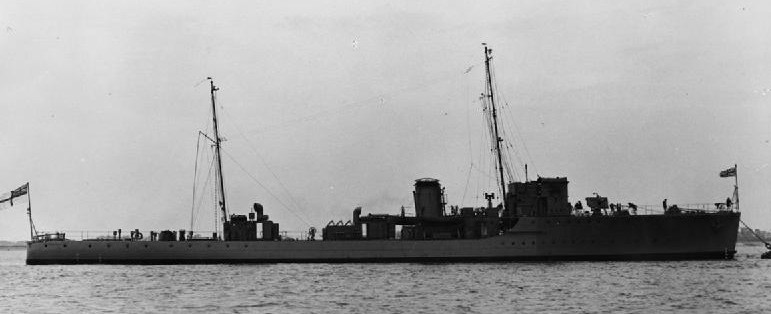The Kingfisher class was an attempt to build a patrol vessel under 600 tons, due to the lack of clauses on vessels this size in the London Naval Treaty of 1930. It was intended it would escort coastal shipping in wartime. Its small size and the resultant short range that this entailed (it was based on a scaled-down destroyer) rendered it unsuitable for open ocean work.
The design had a number of shortcomings: firstly, it was designed to
too high a standard; constructed to full naval warship
specifications and powered by geared steam turbine engines, it was
not suitable for mass production; and, it was armed with only a
single 4-inch gun forward and depth charges aft, which severely
limited their ability to defend themselves, let alone their charges.

The woeful lack of defensive armament was addressed early in the war
by adding a multiple Vickers machine gun
on the quarterdeck in the
Kingfisher
and
Kittiwake
groups, as per the
Shearwaters.
As they became available, two single 20 mm
Oerlikon guns
were added, on single pedestal mounts on the deckhouse aft, with the
useless machine gun being replaced later with a further pair of such
weapons. Centimetric
Radar Type 271
was added on the roof of the bridge as it became available, this was
a target indication set capable of picking up the
conning tower
or even the periscope
or snorkel
of a submarine.
Radar Type 286
air warning was added at the masthead. The ships that had the Mark V
gun on the open mounting HA Mark III had a shield added to give the
gun crews a measure of protection on the exposed
forecastle.
JPG I found on the net, added SB parts to make it
look closer.
| Displacement | 580 tons standard, 750 tons full load. | |
| Length | 243 ft | |
| Breadth | 27 ft | |
| Draught | 6.5 ft | |
| Machinery | 2 shaft, Steam Turbines, 3,000shp | |
| Speed | 20 knots | |
| Range | 1500 miles at 10 knots | |
| Armament | As completed 1 x 4" (1x1) |
Upgrade/Refits 1 x 4" (2x1) 2 x 20mm (2x1) 4 x 0.5"mg (1x4) |
| Complement | 60 | |
| Notes | ||
.jpg)
Kingfisher group
- Kingfisher (L70) — built by Fairfield Shipbuilding and Engineering Company, Govan. Ordered 15 December 1933, keel laid down 1 June 1934, launched 14 February 1935, and completed 18 June 1935. Sold for scrapping 1947.
- Mallard (L42) — built by Alexander Stephen and Sons, Linthouse. Ordered 21 March 1935, keel laid down 12 June 1935, launched 26 March 1936, and completed 15 July 1936. Sold for scrapping 1947.
- Puffin (L52) — also built by Alexander Stephen and Sons, Linthouse. Ordered 21 March 1935, keel laid down 12 June 1935, launched 5 May 1936, and completed 26 August 1936. Rammed and damaged by German midget submarine in North Sea 26 March 1945 and written off as constructive total loss, sold for scrapping 1947.
Kittiwake group
- Kittiwake (L30) — built by John I. Thornycroft and Company, Woolston. Ordered on 21 January 1936, keel laid down 7 April 1936, launched 30 November 1936, and completed 29 April 1937. Sold into mercantile service 1946 as Tuch Shing.
- Sheldrake (L06) — also built by John I. Thornycroft and Company, Woolston. Ordered on 21 January 1936, keel laid down 21 April 1936, launched 28 January 1937, and completed 1 July 1937. Sold into mercantile service 1946 as Tuch Loon.
- Widgeon (L62) — built by Yarrow and Company, Scotstoun. Ordered on 13 January 1937, keel laid down 8 March 1937, launched 2 February 1938, and completed 16 June 1938. Sold for scrapping 1947. Widegon also had pennant number P62.
Shearwater group
- Shearwater (L39) — also built by J. Samuel White and Company, Cowes; ordered 6 April 1938, keel laid down 15 August 1938, launched 18 April 1939, and completed 7 September 1939. Sold for scrapping 1947.
- Guillemot (L89) — built by J. Samuel White and Company, Cowes; ordered 6 April 1938, keel laid down 22 August 1938, launched 6 July 1939, and completed 28 October 1939. Sold for scrapping November 1950.
- Pintail (L21) — also built by J. Samuel White and Company, Cowes; ordered 6 April 1938, keel laid down 22 August 1938, launched 18 August 1939, and completed 28 November 1939. Mined in Humber estuary 10 June 1941.